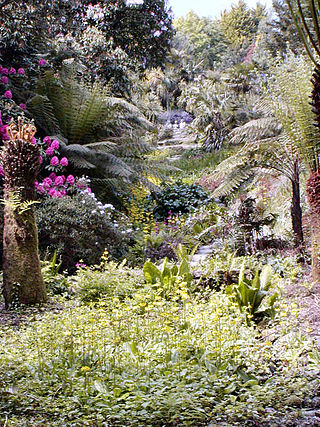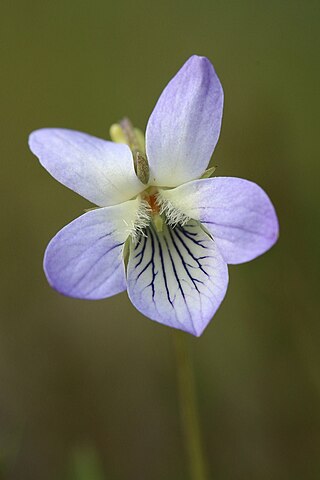
The flora of Wales refers to the plant life in Wales.
Contents
| Part of a series on the |
| Biodiversity of Wales |
|---|
 |

The flora of Wales refers to the plant life in Wales.
| Part of a series on the |
| Biodiversity of Wales |
|---|
 |
The sessile oak ( Quercus petraea ), one of Wales' most common species, can be found across the region. English holly ( Ilex aquifolium ), one of the few native evergreen trees, can be found in southern Wales. The wych elm ( Ulmus glabra ), a native species, suffers from disease and competition introduced by exotic species. [1]
The cuckoo flower ( Cardamine pratensis ), a herbaceous perennial, can be found throughout Wales. Bog rosemary ( Andromeda polifolia ), a small flowering shrub, can be found in central Wales. Within the British Isles, the Snowdon lily ( Gagea serotina ) is found only on the slopes of Snowdon. [2]
Important Plant Areas (IPAs) in Wales are areas of "the highest botanical importance" as determined by Plantlife. [3]
| County / Historic county | Species | Habitat |
|---|---|---|
| Anglesey | Spotted rock-rose (Tuberaria guttata) | Dry, rocky places |
| Brecknockshire | Cuckooflower (Cardamine pratensis) | Wet grassland and pond margins |
| Caernarvonshire | Snowdon lily (Gagea serotina) | Mountain rocks |
| Cardiff | Wild leek ( Allium ampeloprasum ) | Sandy and rocky places near the sea |
| Cardiganshire | Bog-rosemary (Andromeda polifolia) | Mid-Wales |
| Carmarthenshire | Whorled caraway (Carum verticillatum) | Damp meadows |
| Denbighshire | Limestone woundwort (Stachys alpina) | Roadsides and hedges |
| Flintshire | Bell heather (Erica cinerea) | Heaths and moors |
| Glamorgan | Yellow whitlow-grass (Draba aizoides) | Rocks and old walls |
| Merioneth | Welsh poppy (Meconopsis cambrica) | Damp, shady rocks |
| Monmouthshire | Foxglove (Digitalis purpurea) | Woodland clearings, heaths and banks |
| Montgomeryshire | Spiked speedwell (Veronica spicata) | Limestone rocks |
| Pembrokeshire | Thrift (Armeria maritima) | Coastal cliffs or astride craggy islands |
| Radnorshire | Radnor lily (Gagea bohemica) | Limestone rocks |

Anacamptis pyramidalis, the pyramidal orchid, is a perennial herbaceous plant belonging to the genus Anacamptis of the family Orchidaceae. The scientific name Anacamptis derives from Greek ανακάμτειν 'anakamptein' meaning 'bend forward', while the Latin name pyramidalis refers to the pyramidal form of the inflorescence.

Fritillaria meleagris is a Eurasian species of flowering plant in the lily family Liliaceae. Its common names include snake's head fritillary, snake's head, chess flower, frog-cup, guinea-hen flower, guinea flower, leper lily, Lazarus bell, chequered lily, chequered daffodil, drooping tulip or, in the British Isles, simply fritillary. The plant is a bulbous perennial native to the flood river plains of Europe where it grows in abundance.

Temperate rainforests are coniferous or broadleaf forests that occur in the temperate zone and receive heavy rain.

Delonix regia is a species of flowering plant in the bean family Fabaceae, subfamily Caesalpinioideae native to Madagascar. It is noted for its fern-like leaves and flamboyant display of orange-red flowers over summer. In many tropical parts of the world it is grown as an ornamental tree and in English it is given the name royal poinciana, flamboyant, phoenix flower, flame of the forest, or flame tree.

A wildflower is a flower that grows in the wild, meaning it was not intentionally seeded or planted. The term implies that the plant probably is neither a hybrid nor a selected cultivar that is in any way different from the way it appears in the wild as a native plant, even if it is growing where it would not naturally. The term can refer to the flowering plant as a whole, even when not in bloom, and not just the flower.

Anacamptis morio, the green-winged orchid or green-veined orchid, is a flowering plant of the orchid family, Orchidaceae. It usually has purple flowers, and is found in Europe and the Middle East.

Erica vagans, the Cornish heath or wandering heath, is a species of flowering plant in the family Ericaceae, native to Ireland, Cornwall, western France and Spain. It is a vigorous, spreading, evergreen heather reaching 75 cm (30 in) tall and wide, with pink flowers borne in racemes 14 cm (6 in) long in summer and autumn. The Latin specific epithet vagans literally means "wandering"; in this context it means "widely distributed".

Plantlife is the international conservation membership charity working to secure a world rich in wild plants and fungi. It is the only UK membership charity dedicated to conserving wild plants and fungi in their natural habitats and helping people to enjoy and learn about them. HM King Charles III is patron of the charity.

Primula scotica, commonly known as Scottish primrose, is a species of flowering plant in the family, Primulaceae, the primroses and their relatives. It was discovered by James Smith, and is endemic to the north coast of Scotland.

Geranium sylvaticum, the wood cranesbill or woodland geranium, is a species of hardy flowering plant in the family Geraniaceae, native to Europe and northern Turkey.

Neotinea ustulata, the burnt orchid or burnt-tip orchid, is a European terrestrial orchid native to mountains in central and southern Europe, growing at up to 2,400 m (7,900 ft) elevation. The plant is considered Endangered in Great Britain and Least Concern internationally based on IUCN Red List criteria. The burnt-tip orchid was voted the county flower of Wiltshire in 2002 following a poll by the wild flora conservation charity Plantlife.

Pericopsis elata is a species of flowering plant in the family Fabaceae and is known by the common names African teak, afromosia, afrormosia, kokrodua and assamela.

Cornwall is the county that forms the tip of the southwestern peninsula of England; this area has a mild and warm climate regulated by the Gulf Stream. The mild climate allows rich plant cover, such as palm trees in the far south and west of the county and in the Isles of Scilly, due to sub-tropical conditions in the summer.

The flora of Scotland is an assemblage of native plant species including over 1,600 vascular plants, more than 1,500 lichens and nearly 1,000 bryophytes. The total number of vascular species is low by world standards but lichens and bryophytes are abundant and the latter form a population of global importance. Various populations of rare fern exist, although the impact of 19th-century collectors threatened the existence of several species. The flora is generally typical of the north-west European part of the Palearctic realm and prominent features of the Scottish flora include boreal Caledonian forest, heather moorland and coastal machair. In addition to the native varieties of vascular plants there are numerous non-native introductions, now believed to make up some 43% of the species in the country.

The West Cornwall Bryophytes Site of Special Scientific Interest is a group of seven locations of former mining activity, that form a single SSSI and Important Plant Area in western Cornwall, England, United Kingdom. The site is noted for its biological characteristics and derives its name from the rare bryophyte species found there.

The biodiversity of Wales refers to the wide variety of ecosystems, living organisms, and the genetic makeups found in Wales.

The Tomorr Mountain National Park is a national park founded in 1956 that lies in southern Albania, nestled in the central and higher portions of the Tomorr massif, spanning an area of 261.06 km2 (100.80 sq mi) since 2012, and expanded to include its quarry areas since 2019. The park covers a territory of 26,106 ha. The area falls within the Berat County and only 1,278 ha inside the Elbasan County. The park was established in 1956 and is considered one of the most important protected areas for the maintenance of mountainous biodiversity and ecosystem integrity at the national level. The park has been recognised as an Important Plant Area of international importance by Plantlife.
Tropical Important Plant Areas (TIPAs) is a programme established by the Royal Botanic Gardens, Kew in 2015 in collaboration with Plantlife International, to provide a framework to identify sites important for preserving plant diversity in tropical countries. The programme is based on the Important Plant Areas (IPAs) framework set up by Plantlife International. The IPA criteria were modified to take into account the high plant richness, the limited availability of data and the higher dependence on socio-economically important yet native plants for livelihoods in the tropics. The framework acknowledges the practical problems of gathering plant and habitat data in many regions of the world, and it recognises the important role of peer reviewed expert opinion in the selection process. TIPAs can be identified based on a range of organism groups within the plant and fungal kingdoms, including algae, fungi, lichens, liverworts, mosses, and wild vascular plants. The TIPAs programme focuses on critical sites for wild plant populations. It aims to identify areas important for the conservation of threatened plants and/or habitats and areas with exceptional plant richness, and to raise awareness of the importance of plant life in tropical countries, encouraging long term conservation of these areas. TIPA sites are selected based on three criteria:

Rumex rupestris, commonly known as shore dock, is a species of flowering plant belonging to the family Polygonaceae. Its native range is Western Europeand is one of the world's rarest dock species.

Viola lactea, also known by its common name pale dog violet, is a species of flowering planet of the family Violaceae.